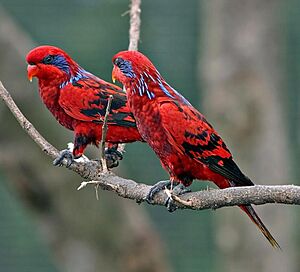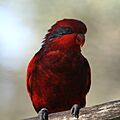Blue-streaked lory facts for kids
Quick facts for kids Blue-streaked lory |
|
|---|---|
 |
|
| At Jurong Bird Park, Singapore | |
| Conservation status | |
| Scientific classification | |
| Genus: |
Eos
|
| Species: |
lotor
|
The blue-streaked lory (Eos lotor) is a colorful parrot. It is also known as the blue-necked lory. This medium-sized bird is about 31 centimeters (12 inches) long. You can find it on the Tanimbar Islands and Babar in the southern Moluccas.
Contents
What Does the Blue-Streaked Lory Look Like?
The blue-streaked lory is about 31 centimeters (12 inches) long. This measurement includes its tail. These birds usually weigh between 145 and 155 grams (about 5 ounces). Both male and female lories look the same.
Colors and Markings
Most of the bird's feathers are a bright, fiery red. You will see electric blue feathers near its ears. There are also blue feathers on the back of its neck. This is how the bird got its name. A dark indigo-violet stripe runs from this area down to the base of its neck. The lower part of the neck and the top of the back are bluish-black. The main part of the back and the rump are red.
Wings, Tail, and Beak
The wing feathers are red with black tips. The top of the tail feathers are reddish-black. The underside of the tail is a softer red color. The lory's eyes are orange-red. Its beak is short, sharply curved, and bright red-orange. The feet are gray, and the claws are black.
Blue-Streaked Lory Behavior and Life
Scientists believe there are between 100,000 and 500,000 blue-streaked lories in the wild.
What Do They Eat?
We don't know exactly what they eat in the wild. However, most lories and lorikeets eat similar foods. Their diet likely includes pollen, nectar, fruit, and some insects.
Calls and Social Life
These lories are known for being quite loud. Their calls are described as a series of shrill screeches. They are very social birds. Blue-streaked lories often travel in noisy groups of up to ten birds.
Lifespan and Breeding
In zoos or as pets, these lories can live for 28 to 32 years. Female lories usually lay two eggs at a time. Sometimes, they might lay three eggs. The eggs hatch after about 25 days. The young birds are ready to fly from the nest around 12 weeks after hatching.
Threats to Blue-Streaked Lories
The main dangers to blue-streaked lories in the wild are two things. First, their homes are being destroyed. This happens because of logging. Forests are also cleared to plant crops like palm trees. Second, people trap these birds to sell them as pets.
Where They Live
These birds live in a small, specific area. However, their groups are still connected. This means they are not in severe danger yet. They like to live in old, untouched forests. They also live in newer forests that have grown back. You can find these parrots in mangrove forests too. They even live in places managed by humans, like coconut farms.
Protecting the Blue-Streaked Lory
The IUCN lists these parrots as "Near Threatened." This means they could become endangered in the future. For international trade, the blue-streaked lory is listed under CITES Appendix II. This means that if people want to buy or sell these birds across countries, they need special permits. This helps control the trade and protect the species.
Blue-Streaked Lories and People
When blue-streaked lories are raised by humans, they can be very friendly and playful. Birds caught from the wild are usually shy. These parrots can easily get used to living with people.
Images for kids







